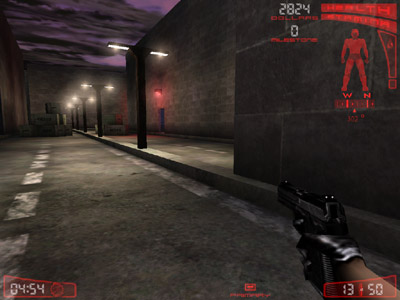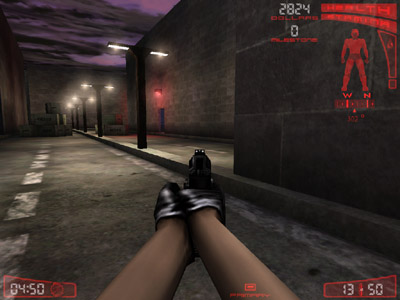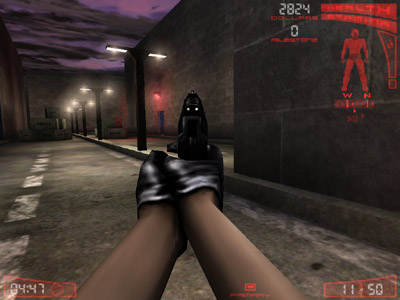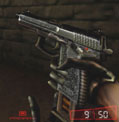
Each weapon has two possible aiming states: high and low. To switch between these two modes, you use the ToggleAim command (bound in the Night's Edge Preferences menu). All weapons, when actived, are brought into low aim mode by default. This can also be referred to as "point shooting" or "shooting from the hip". In low aim mode, the sights aren't aligned with your eye so aiming can be difficult. However, reloading is quicker when initiated in low aim mode, it's faster to switch to another weapon in this mode, and the weapon model will block less of your view in low aim mode.

High aim mode brings the sights of the gun up into alignment with your eye. You can now look down the sights and be assured that where you put the gun's front sight, the bullets will hit. The tricky part is then getting the sight to line up with your target! Any person holding a gun will have a slight tremor in their muscles, because of the weight of the gun and even the weight of their arms. This tremor is visible as a slight random bobbing of the weapon and its sights as you stand still. It is made worse by high fatigue and some types of drugs. Crouching lets you help redistribute weight better, so it lessens the weapon tremor somewhat, especially with heavier weapons.
Movement, though, makes it very difficult to hold a gun steady. The motion of the body makes it harder to keep the gun trained on a particular spot, and the rhythmic slapping of your feet on the ground as you walk or run jars your arms (the faster you move, the more pronounced this effect). This weapon bounce caused by movement is slightly reduced if you're holding the gun in low aim mode.

When the sights form the proper sight picture with your target, you can fire and expect to hit. Now keep in mind that the recoil of most guns will throw your well-placed sights off the target. Generally, the more powerful the ammunition, the more recoil will affect the angle of your gun. You can either pause before your next shot, as the gun sights will settle back to the center of the screen, or you can try and compensate manually by using the mouse to rotate your view until the sights again line up with your target. This is why most weapon experts recommend short, controlled bursts when using fully automatic weapons. It becomes very difficult to keep up with the sights of a wildly recoiling weapon.
Scoped weapons (rifles) don't have iron sights, so when you switch them to high aim mode, you will be looking through their telescopic sights. Your view will be zoomed, and the scope's crosshair will be visible. Switching back to low aim mode returns your view to normal.
All of these effects apply both to high and low aim modes, however they are generally more noticeable in high aim mode since you can see the sights and tell exactly where the gun is pointing. In low aim mode, the gun will still react to a player's movement and recoil. It just may be harder to tell.

-
1 & 2: Cycle to previous and next hand-to-hand weapons
3 & 4: Cycle to previous and next handguns
5 & 6: Cycle to previous and next long guns (submachineguns, rifles, shotguns, machineguns, energy)
7 & 8: Cycle to previous and next grenades
9 & 10: Cycle to previous and next explosives (mines, detonation packs)
Drugs: There are a number of advantageous medications available in the world of Night's Edge. These have varying effects, but all work the same way. They can either be used through the Inventory menu or with an individual key bind. Drugs, while taking effect immediately, will still have a pause of about 1 second between each use, so you cannot multiple doses one right after the other. Be warned, mixing different types of medication can cause dangerous side-effects and drug interactions.
Flashlight: Every player is equipped with a flashlight. This small but powerful device puts out a dazzling amount of illumination and contains enough battery life for 20 hours of continual use. The flashlight can be toggled on and off using the key bound in the Controls menu.
Available armor comes in different levels, and each piece can cover a different part of the body. The higher the rating level, the more resistant the armor is to puncture. A helmet protects the head and face from attack, while chest armor clads the arms and torso. Leg armor defends the legs, feet, posterior, and crotch from harm. Players should feel free to mix and match their armor levels if they want (for example, you might buy better armor for your head if you can't afford armor that good for your entire body).
Even though armor may prevent a bullet or other attack from penetrating into your soft, tender flesh, even the impact from the attack may be enough to cause harm to your person. Don't get it into your head that armor makes you invulnerable to harm. It doesn't.